First Look: Samsung Galaxy S8
by Matt Humrick on April 21, 2017 8:55 AM EST- Posted in
- Smartphones
- Samsung
- Galaxy
- Mobile
- Snapdragon 835
- Galaxy S8
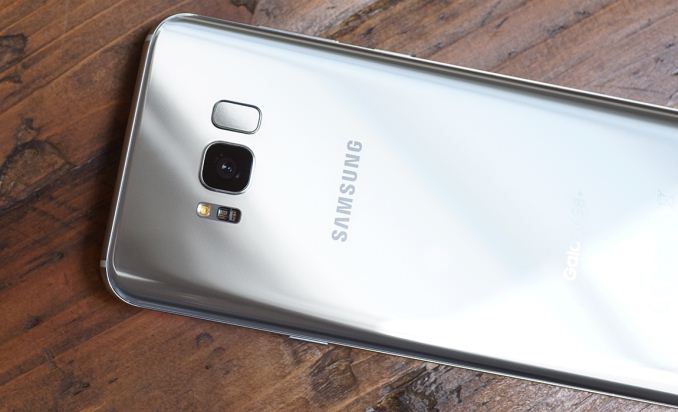
We first saw Samsung’s new 5.8-inch Galaxy S8 and 6.2-inch Galaxy S8+ at its Unpacked event a few weeks ago. During the event, we saw demos of its new virtual assistant, Bixby, and its DeX docking station, which allows the Galaxy S8 to provide a desktop-like experience by connecting to an external monitor and peripherals, but we didn’t have much time with the phones to do much more than take some pictures and try a couple of the new features. After receiving a Galaxy S8 earlier this week, we wanted to give you some feedback about its design and biometric features, as well as, an initial performance and battery life assessment before we dive into our usual in-depth testing.
My biggest complaint about the design is the location of the fingerprint sensor, which I discuss in the video above. It has been relocated to the back next to the camera, making it difficult to reach and use. The new face unlock feature, the second of the S8’s three biometric authentication options, is flawed too. Despite my best efforts, I was not able to get face unlock to work, not even once. The feature, which relies solely on the front-facing camera for identification, also is not very secure, assuming it works at all. It has already been shown that simply holding a picture in front of the camera is enough to fool it into unlocking the phone. The camera really needs to be augmented with an infrared camera to detect a face’s heat signature as a liveness test, or a second, depth-sensing camera to at least detect a face in three dimensions. So far the iris scanner, which I also demo in the video above, has proven to be the easiest and most reliable biometric option.
| Samsung Galaxy S8 Series | ||
| Samsung Galaxy S8 | Samsung Galaxy S8+ | |
| SoC | Qualcomm Snapdragon 835 (US, China, Japan) 4x Kryo 280 Performance @ 2.35GHz 4x Kryo 280 Efficiency @ 1.90GHz Adreno 540 Samsung Exynos 8895 (rest of world) 4x Exynos M2 @ 2.30GHz 4x Cortex-A53 @ 1.70GHz ARM Mali-G71 |
|
| Display | 5.8-inch 2960x1440 (18.5:9) SAMOLED (curved edges) |
6.2-inch 2960x1440 (18.5:9) SAMOLED (curved edges) |
| Dimensions | 148.9 x 68.1 x 8.0 mm 155 grams |
159.5 x 73.4 x 8.1 mm 173 grams |
| RAM | 4GB LPDDR4 (US) | |
| NAND | 64GB (UFS) + microSD |
|
| Battery | 3000 mAh (11.55 Wh) non-replaceable |
3500 mAh (13.48 Wh) non-replaceable |
| Front Camera | 8MP, f/1.7, Contrast AF | |
| Rear Camera | 12MP, 1.4µm pixels, f/1.7, dual-pixel PDAF, OIS, auto HDR, LED flash | |
| Modem | Snapdragon X16 LTE (Integrated) 2G / 3G / 4G LTE (Category 16/13) Samsung LTE (Integrated) 2G / 3G / 4G LTE (Category 16/13) |
|
| SIM Size | NanoSIM | |
| Wireless | 802.11a/b/g/n/ac 2x2 MU-MIMO, BT 5.0 LE, NFC, GPS/Glonass/Galileo/BDS | |
| Connectivity | USB Type-C, 3.5mm headset | |
| Features | fingerprint sensor, heart-rate sensor, iris scanner, face unlock, fast charging (Qualcomm QC 2.0 or Adaptive Fast Charging), wireless charging (WPC & PMA), IP68, Mobile HDR Premium | |
| Launch OS | Android 7.0 with TouchWiz | |
Inside the redesigned Galaxy S8 and S8+ is either a Qualcomm Snapdragon 835 or Samsung Exynos 8895 SoC. The US and other regions that require CDMA capability will get the Snapdragon 835, while the rest of the world will get Samsung’s SoC. The new 10nm SoCs are paired with 4GB of LPDDR4 RAM and 64GB of UFS 2.1 NAND. The Galaxy S8 comes with a 3000mAh battery, the same size as the Galaxy S7, while the S8+ comes with a 3500mAh battery, slightly less than the S7 edge’s 3600mAh capacity.
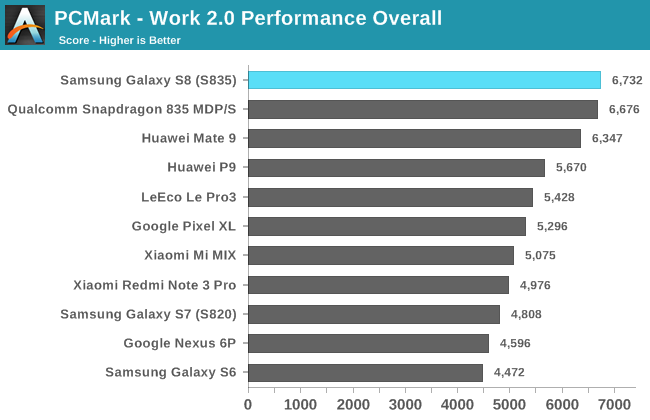
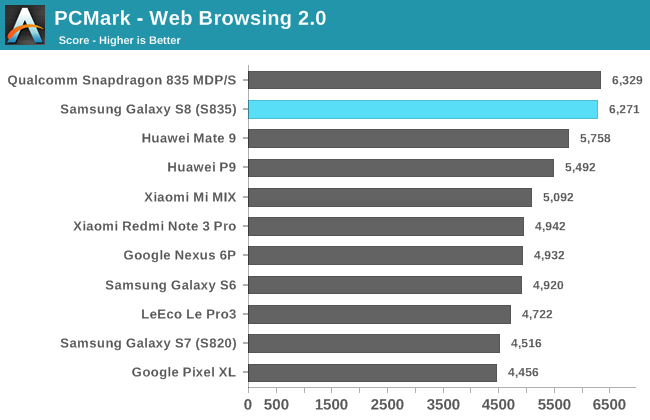
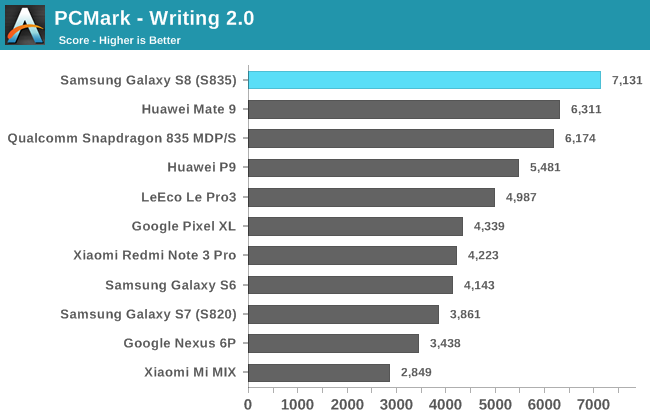
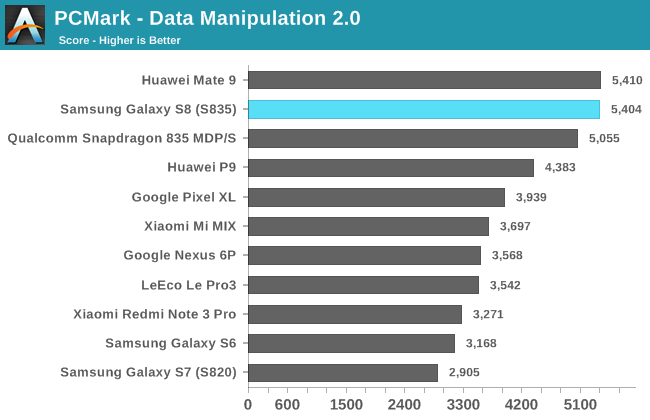
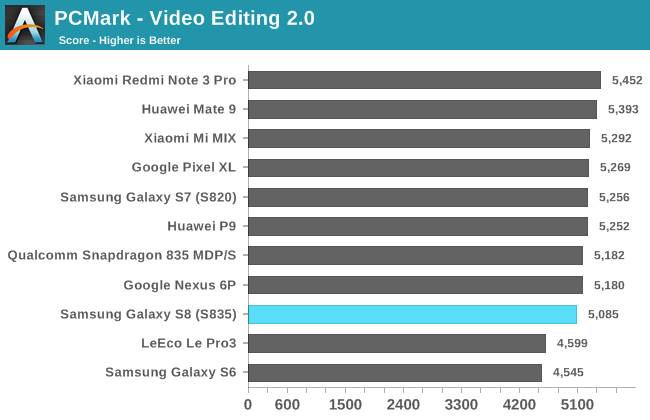
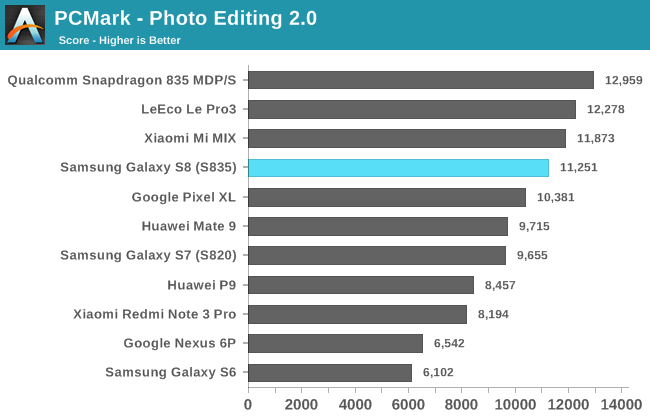
In PCMark, which is our best indicator of general system performance, the Galaxy S8 with Snapdragon 835 performs quite well, besting even the Mate 9 overall. Because this is the first S835 retail device we’ve tested, I’ve also included Qualcomm’s Snapdragon 835 MDP/S, which the company uses internally for hardware testing and software development, as a reference point. In most of these tests, the Galaxy S8 performs about the same as the Snapdragon 835 MDP/S, which is certainly a good sign.
The Galaxy S8 does particularly well in the Writing test, outscoring the Mate 9 by 13% and the Galaxy S7 (Snapdragon 820) by 85%. The Writing test, which previous Galaxy phones struggle with, uses a fairly bursty workload, frequently migrating threads between the little and big cores. Perhaps this is an indication that Samsung is utilizing the big cores more aggressively than in the past. The Galaxy S8 is also 9% faster than the Mate 9 in the Web Browsing test and 37% faster than the S7 (S820).

The Galaxy S8 achieves over 8 hours of screen-on-time while continuously crunching through the PCMark workloads, 46% longer than the Galaxy S7 that has the same 3000mAh battery, which suggests some nice efficiency gains from the new SoC, display, or other components. While the Galaxy S7 can struggle to last a full day on a single charge depending on how it’s used, these initial results suggest the Galaxy S8 will encounter fewer scenarios where it will need to use its fast charging or wireless charging abilities to stretch battery life till the end of the day.
While we’ve only had the Galaxy S8 for a couple of days, our first impression is generally positive. It’s packed with features, TouchWiz is more refined, and it performed well in our first performance and battery life tests. A few issues are already apparent, however. Your face probably will not be smiling if you try to rely on it to unlock the phone, and the fingerprint sensor is located in just about the worst possible place. Samsung’s Bixby assistant also is not yet fully functional; fortunately, you can still use Google Assistant while you’re waiting for Bixby to mature.










129 Comments
View All Comments
amdwilliam1985 - Sunday, April 23, 2017 - link
Any chance of checking on the file system? maybe they're finally move to f2fs, which they've invented?Can anyone shine a light to why f2fs is not being widely use yet?
As far as I'm aware of, OnePlus 3T(soon OnePlus 3) are the only phone(s) that's using f2fs that was invented at Samsung, why?
FreidoNumeroUno - Monday, April 24, 2017 - link
Whatever it is, I really hate curved display, except when it was really curved on note 4 edge. I would like the display to be convex curved. But not like that on Samsung phones. I just don't get the point. It will make the reflection double.Then I hated s7 edge. The ordinary model is okay, the flat faced one. But curved is really annoying.
I like the s8 rear though. Camera seems better than iphone. But still, considering the queer skin Samsung has on its nougat on s8 makes it really fakey.
The finger print arrangement seems childish. Sony has it best. Iphone comes second. Samsung comes last now. Their display is gorgeous. But best for media. Everything else, it's too much distraction. Phone should be of assistance. Not of distraction. It's too long as well.
Is it true that Google pixel git the best cam? Can't believe. Are they using true free andro? Or do they have some proprietary piece of software in pixel now?
shm224 - Monday, April 24, 2017 - link
Why does Anandtech continue to use web/js/browser benchmark ( web bbrowsing 2.0) misleadingly to compare the same underlying hardware (qualcomm 850 vs Samsung 850)?wpwoodjr - Monday, April 24, 2017 - link
I love the face recognition and HATE the fingerprint reader. Half the time the fingerprint reader doesn't work, and I can't use it without looking to make sure I'm not hitting the camera lens. The LG G6 fingerprint reader was amazing, never had any issues with it even with dry fingers. I have found the face recognition works REALLY well, it hasn't failed yet. Perhaps not as secure, but I think I would be taking the S8 back if I had to rely on the crappy Samsung fingerprint reader.Galactica727 - Tuesday, April 25, 2017 - link
So the Galaxy S8 is not using LPDDR4X RAM?Didiron - Wednesday, April 26, 2017 - link
Follow this huge source for latest daily news updates on galaxy S8, great place for anyone who is planning to buy one... http://mobilenewsflash.com/search/galaxy%20S8hassantd - Thursday, April 27, 2017 - link
Brand new Original Samsung Galaxy s8 and s8+ New Edition RED Apple iphone 7 and 7 128GB plus cost 550usd with 1year warranty.Serious buyer should contact us.
hassantd - Thursday, April 27, 2017 - link
Brand new Original Samsung Galaxy s8 and s8+ New Edition RED Apple iphone 7 and 7 128GB plus cost 550usd with 1year warranty.Serious buyer should contact us.
Skype: faisa.hassan102
Basilisk - Friday, April 28, 2017 - link
I've had Zero problems with facial recognition - unless I forget to put on my glasses. In fact, it has an unnerving tendency to recognize me and log me on before I've thought about "posing". That a photo can fool it seems sad, but I can't imagine anyone knowing me and able to take a good pix would consider it, save as a prank.UtilityMax - Friday, April 28, 2017 - link
Call me another hater, but I will add my voice who are calling out S8's gimmicky and impractical exterior design. The curved screen edges mean that the image will be distorted at the boundaries. The curved screen and a glass back means that the grip without an external case will be poor and it will be easy to register false input while simply trying to hold the phone. The curved screen edges make using an external case on this phone very clumsy and impractical. The edge of the phone that has a case still is not protected from the impacts as you can't cover the viewable screen estate at the edges. Finding a curved protective glass cover that covers the entire screen will be problematic. These things don't always stick even to the flat screens, so forget about a curved one..The QHD screen is another gimmick that will mostly result in increased battery drain without obvious benefits. You can reduce the resolution, but that will actually look less accurate than displaying the same image on a true FHD screen because the pixels of the QHD screen will not align with the pixels that should have been on a FHD screen. It has been pretty much the rule of thumb that you want to run the LCDs at their native resolution because of this.
And what else can I say? This device will come loaded with Samsung and carrier crap, resulting in 200+ pre-installed apps on a new device, which will take up storage, CPU cycles, and drain the battery faster.
Because of these arguments, the Pixel family and the Oneplus 3T are still the best high end Android smartphones because they come with relatively lean ROMs, and carrier-indenpendent unlocked editions of Pixel are available.